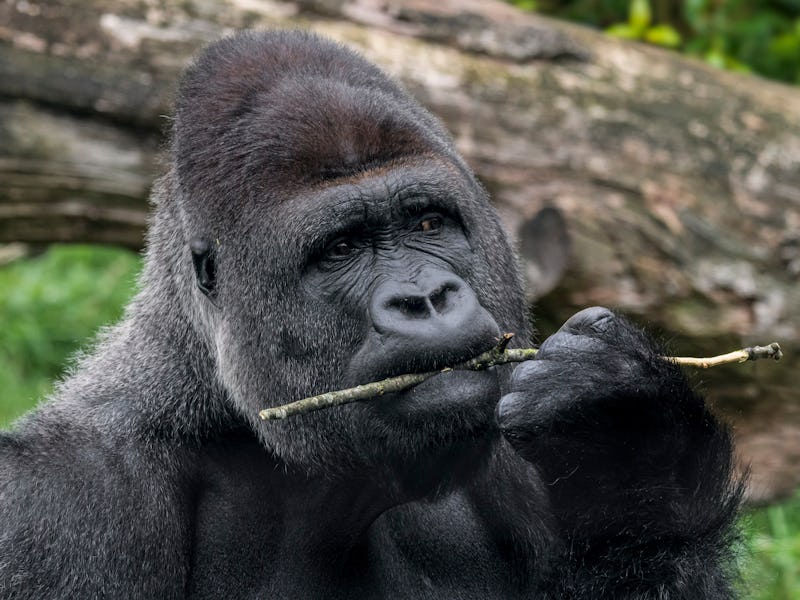Eerily human trait suggests gorillas aren't as chill as we thought
Turns out social relationships are complicated for our closest primate relatives, too.

A new behavioral study shows that humans and gorillas may share more traits in common than scientists first thought.
The new study upends a long-held belief that gorillas — unlike humans — are pretty chill about others passing through what they consider to be their territory. This is the first evidence researchers have that, when it comes to territory, western lowland gorillas understand the concept of ownership — and when another gorilla trespasses on their turf, things can get ugly.
Researchers monitored the movements of eight groups of western lowland gorillas, Gorilla gorilla gorilla, at the Ngaga Research Site in the Republic of Congo. They analyzed camera-trap footage of the gorillas taken across a year and half, from January 2015 to July 2016. What they found, while subtle, was unmistakable: Gorillas are just as protective of their property as we are.
Researchers found that gorillas are less likely to eat at a site another group had visited earlier in the day, for instance. They also seemed to move around based on, at least partially, how close they were to the center of a neighboring group’s home range, suggesting they were trying to steer clear of one another.
(a) Location of Ngaga Research Site in the Republic of Congo. (b) Locations of cameras and home range centers of eight gorilla groups. (Black dots indicate camera locations.) (c) Example camera image. (d) The predicted presence of eight gorilla groups with distance from their home range center.
"Our findings indicate that there is an understanding among gorillas of 'ownership' of areas and the location of neighboring groups restricts their movement,” lead author Robin Morrison, a postdoctoral student at the University of Cambridge, said in a statement.
The research was published Thursday in the journal Scientific Reports.
Gorillas, chimps, humans
The findings contradict previous thinking about the habits of these close human relatives. Gorilla territories tend to have a far reach and significant overlap, so scientists didn’t think the primates were too hung up on personal space. They also show little aggression between groups, the researchers say.
Indeed, this relaxed attitude towards others was long considered the key difference between gorillas and another close human relative, chimpanzees. These apes, along with bonobos, are considered to be the closest relatives of humans.
"Gorillas don't impose hard boundaries like chimpanzees,” Morrison said.
“Instead, gorilla groups may have regions of priority or even exclusive use close to the centre of their home range, which could feasibly be defended by physical aggression.”
And while gorillas are less aggressive than their primate peers, this video from the new research shows just how heated things can get when spatial boundaries are crossed (sound on):
However, just like us humans, gorillas have complicated social rules — that means different infractions mandate different responses.
Groups "can overlap and even peacefully co-exist in other regions of their ranges,” Morrison said.
“The flexible system of defending and sharing space implies the presence of a complex social structure in gorillas."
For example, the researchers include a video of what it looks like when such interactions are chill:
The findings, the researchers say, inform our understanding of human evolution, too. They may even provide evidence of the evolutionary basis for warfare between humans.
"Our research broadens this out and shows instead just how closely we compare to our next nearest relatives,” study co-author Jacob Dunn, a researcher at Anglia Ruskin University, said in a statement.
“Gorillas' core areas of dominance and large zones of mutual tolerance could help with our understanding of the social evolution of early human populations,” he said.
The gorillas show that our primate relatives share “both the capacity for violence in defending a specific territory and the between-group affiliations necessary for wider social cooperation," he said. Much like us humans who have depended on the joint skills of cooperation, adaptation, and exploration for evolutionary success, these same social behaviors may enable our closest primates to thrive, too.
Abstract: The evolutionary origins of how modern humans share and use space are often modelled on the territorial-based violence of chimpanzees, with limited comparison to other apes. Gorillas are widely assumed to be non-territorial due to their large home ranges, extensive range overlap, and limited inter-group aggression. Using large-scale camera trapping, we monitored western gorillas in Republic of Congo across 60 km2. Avoidance patterns between groups were consistent with an understanding of the “ownership” of specific regions, with greater avoidance of their neighbours the closer they were to their neighbours’ home range centres. Groups also avoided larger groups’ home ranges to a greater extent, consistent with stronger defensive responses from more dominant groups. Our results suggest that groups may show territoriality, defending core regions of their home ranges against neighbours, and mirror patterns common across human evolution, with core areas of resident dominance and larger zones of mutual tolerance. This implies western gorillas may be a key system for understanding how humans have evolved the capacity for extreme territorial-based violence and warfare, whilst also engaging in the strong affiliative inter-group relationships necessary for large-scale cooperation.